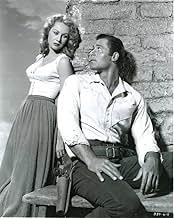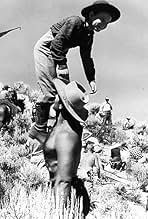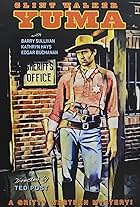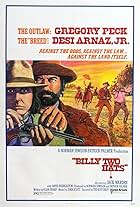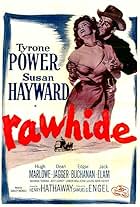VALUTAZIONE IMDb
6,8/10
922
LA TUA VALUTAZIONE
Aggiungi una trama nella tua linguaEluding a sheriff's posse, an escaped man saves a farming family from a Comanche attack and escorts it to the nearby Fort Dobbs.Eluding a sheriff's posse, an escaped man saves a farming family from a Comanche attack and escorts it to the nearby Fort Dobbs.Eluding a sheriff's posse, an escaped man saves a farming family from a Comanche attack and escorts it to the nearby Fort Dobbs.
Roydon Clark
- Largo Refugee at Fort
- (non citato nei titoli originali)
John Cliff
- Largo Refugee at Fort
- (non citato nei titoli originali)
Gene Coogan
- Largo Refugee at Fort
- (non citato nei titoli originali)
Clyde Howdy
- Mr. Gray
- (non citato nei titoli originali)
Richard LaMarr
- Largo Refugee at Fort
- (non citato nei titoli originali)
John McKee
- Largo Refugee at Fort
- (non citato nei titoli originali)
Trama
Lo sapevi?
- QuizAt roughly the 86-minute mark, the famous Wilhelm Scream can be heard when a cowboy is struck with a tomahawk.
- BlooperThe flag flying over the fort has 37 stars, in a 7-8-7-8-7 row pattern. The actual 37-star flag of the U.S. from July 4, 1867 until July 3, 1877 had an 8-7-7-7-8 row pattern, with the end stars on the first and last row extending over the other three rows.
- ConnessioniReferenced in Svengoolie: The 7th Voyage of Sinbad (2010)
Recensione in evidenza
Fugitive Gar Davis (Walker) flees from posse across hostile Comanche territory with woman and small boy (Mayo & Eyer), and encounters old foe, the gun-running Clett (Keith).
Fine eyeful of parched southwestern scenery—I counted only one interior (the "hospital" scene) for the entire movie. Sure, Big Clint (not Eastwood) has only one "Yes, ma'm, No, ma'm" demeanor for every scene, but that's okay, even if he didn't get to be the next Gary Cooper.
Putting old-pro Gordon Douglas in charge was a shrewd move. Note the stages the awakening Mayo goes through in discovering that, yes, Walker has stripped off her wet clothes. Note too how Douglas gets that infernal glint in Mayo's eyes when she first suspects Clint of murdering her husband—it's almost scary. I also like the way the Indians are credited with some military sense when overturning the wagons to make shooters' barricades. Most important, Douglas knows how to integrate the picturesque terrain into the storyline—catch that great framing of the Walker-Keith shoot-out.
Fortunately, Warners got Burt Kennedy to do the script— and on the eve of his outstanding work with the Boetticher-Scott ,(Ranown), cycle of Westerns. I suspect Bryan Keith's charming villain was Kennedy's inspiration since likable baddies was a standard Ranown feature. Yes indeed, Keith steals the show with his easy-going charm—a real contrast to the uptight Walker. At this early stage, Keith was an interesting actor, best at squinty-eyed cowpokes as Sam Peckinpah knew when casting him as lead in Peckinpah's brilliant but short-lived TV series The Westerner (1960).
The movie itself may have been a hurry-up job—probably that's why there's no Technicolor despite the great scenery, and probably why we get a recycled plot line from Hondo (1953). I guess the hurry-up was to take advantage of Walker's TV popularity. Still, the movie's a very watchable action-filled adventure. What's more, I don't care if the luscious Mayo was pushing 40, she could put her saddle on my horse any day.
Fine eyeful of parched southwestern scenery—I counted only one interior (the "hospital" scene) for the entire movie. Sure, Big Clint (not Eastwood) has only one "Yes, ma'm, No, ma'm" demeanor for every scene, but that's okay, even if he didn't get to be the next Gary Cooper.
Putting old-pro Gordon Douglas in charge was a shrewd move. Note the stages the awakening Mayo goes through in discovering that, yes, Walker has stripped off her wet clothes. Note too how Douglas gets that infernal glint in Mayo's eyes when she first suspects Clint of murdering her husband—it's almost scary. I also like the way the Indians are credited with some military sense when overturning the wagons to make shooters' barricades. Most important, Douglas knows how to integrate the picturesque terrain into the storyline—catch that great framing of the Walker-Keith shoot-out.
Fortunately, Warners got Burt Kennedy to do the script— and on the eve of his outstanding work with the Boetticher-Scott ,(Ranown), cycle of Westerns. I suspect Bryan Keith's charming villain was Kennedy's inspiration since likable baddies was a standard Ranown feature. Yes indeed, Keith steals the show with his easy-going charm—a real contrast to the uptight Walker. At this early stage, Keith was an interesting actor, best at squinty-eyed cowpokes as Sam Peckinpah knew when casting him as lead in Peckinpah's brilliant but short-lived TV series The Westerner (1960).
The movie itself may have been a hurry-up job—probably that's why there's no Technicolor despite the great scenery, and probably why we get a recycled plot line from Hondo (1953). I guess the hurry-up was to take advantage of Walker's TV popularity. Still, the movie's a very watchable action-filled adventure. What's more, I don't care if the luscious Mayo was pushing 40, she could put her saddle on my horse any day.
- dougdoepke
- 14 mar 2010
- Permalink
I più visti
Accedi per valutare e creare un elenco di titoli salvati per ottenere consigli personalizzati
- How long is Fort Dobbs?Powered by Alexa
Dettagli
- Tempo di esecuzione1 ora 33 minuti
- Colore
- Proporzioni
- 1.85 : 1
Contribuisci a questa pagina
Suggerisci una modifica o aggiungi i contenuti mancanti

Divario superiore
By what name was L'urlo dei comanches (1958) officially released in India in English?
Rispondi



